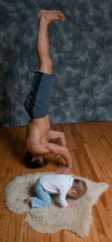
“one reason why i created the “hold n’ hover” techniques in HP Yoga� – such as those inherent to my uniquely brutally yet bountiful for you “HP Prop Workout�”is due precisely to the need to internally support posture without collapsing upon the CT/skeleton. HP Yoga� is a very organ-ic approach to suppleness and strength and energetic development; it focuses on strengthening the organs so the inner strengthens the outer. if this is not followed, then you just create laxity within joint capsules that will turn you into a specimen of fragile specificity instead of a yogic warrior whose skills can be applied to all disciplines, all sports, all actions…” – coach ilg. photo by; waynewilliamsstudio.com
***
Ilgbro,
Any input on this guy’s question? I don’t think fascia is something that can be strengthened like muscle–more of an elastic capsule. Yes it can “grow” with muscle hypertrophy no matter what the training methodology applied i.e. body weight exercise, heavy weights, etc.–but not really the same kind of growth for the same reasons. Not sure how to answer this one–you’re more on top of this than me…I would like to learn your opinions.
Bowed,
rj
Here is his question:
*
Hello,
I had a few questions concerning fascia in strength. First, can high rep calisthenics (100-500 for example) help increase the strength/growth of one’s fascia? What about isometrics? Is it true that those with developed fascia are super strong, even more so than weight lifters? Thanks very much for your time!
-Devin
*
COACH RESPONDS TO RJ
Noble RJ,
i’ll do something more formal as a DL later, however, for now
the short answer here is that FCT (fascia connective tissue) does not undergo hypertrophic adaptation
like skeletal muscle. FCT does not have significant neural, vascular, or nadic pathways to do so. at best,
fascia undergoes an elastic/plastic degree of change relative to the musculature and/or structural
adaptations of which it surrounds…which is precisely why asana and stretching
must be artfully, if not scientifically, applied while maintaining a high Priority on an individual’s
sense of kinesthesia. This is why one-on-one training with a Teacher is so important. there are
a whole lot of CT injuries out there caused by avidya (ignorance).
one reason why i created the “hold n’ hover” techniques in HP Yoga� is due precisely to the need
to internally support a posture without collapsing upon the CT/skeleton. HP Yoga� is an organ-ic
approach to suppleness and strength; it focuses on strengthening the organs so the inner strengthens
the outer.
i will envision that this helps you and your student until i can write more on this.
head bowed,
coach ilg

 These teachings are the "Rasas" or "sap" of Wholistic Fitness. You’ll find insights to ponder, student chi to keep your own chi topped off, and plenty of proven training techniques to test on your own body, mind, and spirit! Also, you’ll find my very popular Race Reports, and news of our Sangha’s (community’s) latest transpersonal fitness adventures!
These teachings are the "Rasas" or "sap" of Wholistic Fitness. You’ll find insights to ponder, student chi to keep your own chi topped off, and plenty of proven training techniques to test on your own body, mind, and spirit! Also, you’ll find my very popular Race Reports, and news of our Sangha’s (community’s) latest transpersonal fitness adventures!